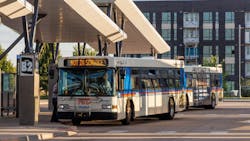Denver RTD adds live look-in equipment in case of an emergency situation to all buses
The Denver Regional Transportation District (RTD) has added live look-in equipment in case of an emergency situation to all of its buses.
The live look-in software – paid for by an approximately $2.4 million U.S. Department of Homeland Security grant Denver RTD was awarded in September 2020, which also includes professional services and five years of maintenance – supersedes a system on agency buses for decades. Using the prior technology, dispatch could only hear audio inside the bus.
With the addition of the live look-in system, Denver RTD’s public safety dispatchers can use a secure, cellular network connection to hear audio and view video in real time from the cameras on board that vehicle. The new approach helps bus dispatch and Transit Police better understand an issue, including how to assist employees and the public in a timely manner.
“Transit Police pursued the project because the prior system was approaching the end of its useful life, said Israel Laufer, Denver RTD’s integrated security systems program manager. “We already had cellular connectivity onboard our vehicles so we wanted to capitalize on it. “We were looking for technology innovations and thinking ahead.”
Denver RTD notes each one of its buses has the capability to house the system, both the agency’s own vehicles and those operated for the agency by contractor Transdev. Installation of the new software began in early 2023.
As of July 15, the agency says about 19 percent of its light-rail vehicles also have had live look-in capability added. The remainder of the fleet must be retrofitted for the ability by June 2027 in accordance with state requirements.
“Commuter rail vehicles, maintained by concessionaire Denver Transit Partners, already have this capability on the company’s own private wireless network, using a system separate from [Denver] RTD’s, Laufer said.
The agency notes all system user activity is tracked and recorded. All system users have received training to reinforce the system is to be used only to observe and report serious safety hazards.
The new software also evolves Denver RTD’s ability to retrieve video for investigations. According to Denver RTD Intelligent Transportation Systems Manager Tom Hughes, approximately 30 years ago, when digital video recorders were first placed on buses, hard drives had to be physically pulled from the vehicle for review.
Laufer notes that during the last decade, the addition of Wi-Fi to buses allowed investigators to capture video only after the vehicle pulled into the garage at night and all the data had been downloaded through a Wi-Fi connection. Now, information can be reviewed and retrieved in the moment.
“There's nothing like a dispatcher looking at the live look-in and explaining over the radio and describing the suspect, who and where he left, what station, what location. That’s a million dollars right there,” Laufer said. “The operator is so busy with driving the bus and so many things are happening that the live look-in system relieves the operator from focusing on a precise description: Was he wearing a red vest, a baseball hat, a black shirt? Now, all they have to do is press a silent alarm button and people will be able to help them out, to get the exact description out and what happened and be able to view both live video, as well as the video playback of what occurred.”
While not new, Hughes notes this type of software is becoming more commonplace as mobile communication technology advances and transit agencies understand the advantages it can provide.
“I am proud to say that the system is being used hourly and daily and I can see the system dashboard, video retrievals and statistics,” Laufer said.
